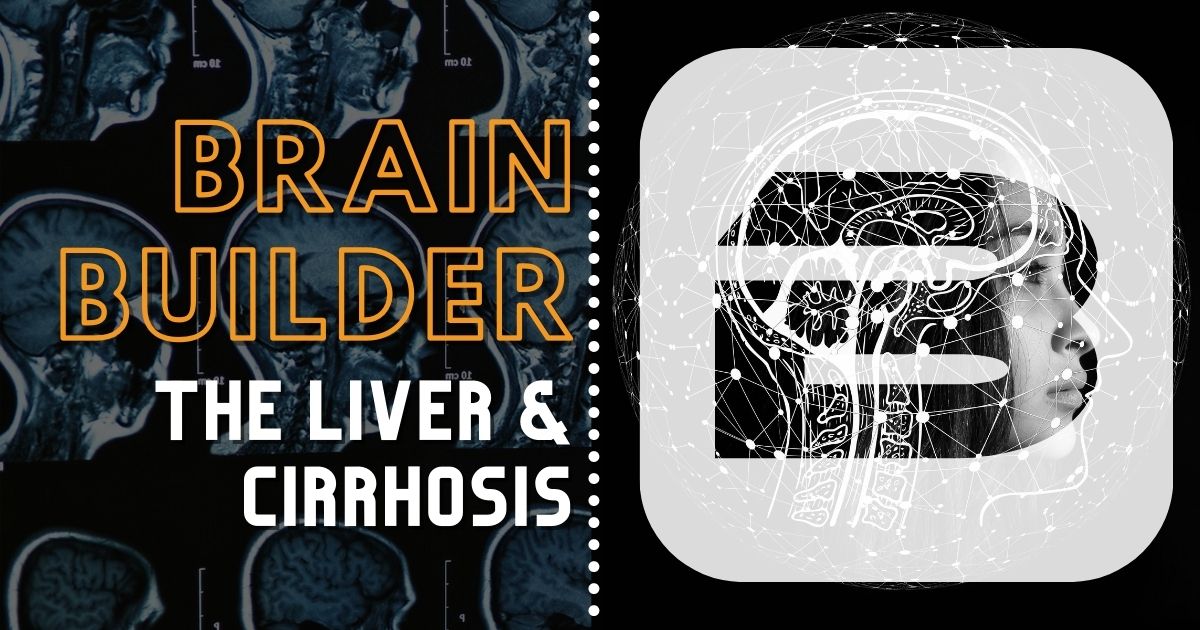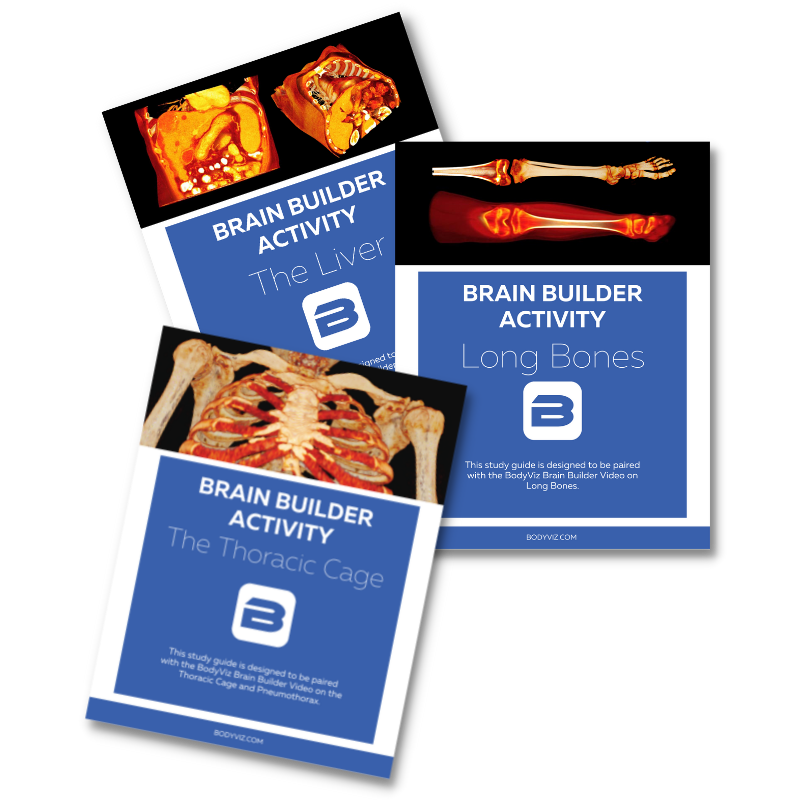The Liver and Cirrhosis | 3D Anatomy Software
January 19, 2022

Short video explaining the functions of the liver and cirrhosis with a patient example!
The liver is the largest gland in the body and is a lobed glandular organ that is involved in many metabolic processes. The liver has hundreds of vital functions. In this article we are going to focus on three of the liver's functions: filtering blood, processing nutrients, and producing bile. Because the liver produces bile, it is considered an accessory organ of the digestive system. However, do not let the word “accessory'' deceive you - the liver is an important player when it comes to your well being and performing body functions. Let’s learn more about the liver and about these two important functions.
The Liver
The liver is located directly inferior to your diaphragm in the right upper quadrant of the abdominal cavity with protection from the ribs. The liver is divided into 2 primary lobes: a larger right lobe and smaller left lobe. The large right lobe can be divided into an inferior quadrate lobe and a posterior caudate lobe. The quadrate lobe is on the inferior surface of the liver, just left of the gallbladder and the caudate lobe is on the posterior surface of the liver, surrounding the inferior vena cava. There are 6 peritoneal folds termed ligaments that connect the liver to the abdominal wall and diaphragm:
- Falciform ligament - attaches to the anterior abdominal wall and inferior surface of the diaphragm.
- Coronary ligament - connects the liver to the diaphragm, posterior abdominal wall, right kidney, right suprarenal (adrenal) gland, and right triangular ligament.
- Two triangular ligaments (right and left) - both are continuations of the coronary ligament and connect to the falciform ligament and lesser omentum.
- Ligamentum teres hepatis - partially connects to the ligamentum venous.
- Ligamentum venosum - forms the ductus venous and attaches to the inferior vena cava.
- Lesser momentum ligament - attaches to the abdominal esophagus, the superior portion of the duodenum, and inferior portion of the liver.
The falciform ligament and the ligamentum teres are remains of the umbilical vein during fetal development, and separate the right and left lobes anteriorly.
Blood Filtration
The liver functions to filter blood of any toxins and process nutrients through a filtration process. The liver does this through a filter process that begins with the hepatic artery and hepatic portal veins entering the liver at the porta hepatis. The root word hepaticus is Latin for “pertaining to the liver”. The hepatic artery delivers oxygenated blood from the heart to the liver and the hepatic portal vein delivers partially deoxygenated blood from the stomach, pancreas, spleen, and the small and large intestine to the liver. The liver processes the bloodborne nutrients and toxins from the blood, and releases the nutrients back into the blood through the central vein and then the hepatic vein which drains into the inferior vena cava.
Bile Secretion
The histology of the how the liver filters blood and secretes bile are closely related and involve these three main components which we will discus in this section:
- Hepatocytes
- Bile canaliculi
- Hepatic sinusoids
The hepatocyte is the main cell comprising the liver and making up 80% of the liver’s size. Hepatocytes are cells that perform a variety of functions including secretory, metabolic, and endocrine functions. Between connecting hepatocytes, there are small ducts that run along the surface and fit into the grooves of the cell membranes of the hepatocytes. These small ducts are bile canaliculi that accumulate the bile being produced by hepatocytes. The small ducts unite to form larger bile ducts and eventually become the left and right hepatic ducts. The left and right hepatic ducts carry the bile out of the liver and eventually merge into the common hepatic. The right and left hepatic ducts unit and form the common hepatic duct which carries bile towards the gallbladder. Bile enters the duodenum of the small intestine from the gallbladder.
Bile is a digestive fluid that is produced by the liver and stored in the gallbladder that breaks down fats/lipids. Bile is secreted from the small intestine to assist in digestion. Bile is secreted by muscular contractions that force bile from the gallbladder into the duodenum of the small intestine. Bile is composed of bilirubin, water, bile salts, bile pigments, phospholipids, electrolytes, cholesterol, and triglycerides. Bilirubin is the main component of bile and is produced when the liver breaks down old red blood cells.
Hepatic sinusoids are vascular structures that receive nutrient-rich blood from the hepatic portal veins and oxygen-rich blood from the hepatic arteries, and transport the blood to the hepatocytes. Hepatic sinusoids do not have a continuous wall and have a discontinuous basement membrane which makes them different from other vascular structures. As the oxygen and nutrient-rich blood passes by the hepatocytes, the hepatocytes are able to filter the wastes and toxins, and process the nutrients carried within the blood.
After the blood has been filtered through the hepatocytes, the hepatic sinusoids transports the blood to a central vein of the hepatic lobule. This blood then flows into interlobular veins, which eventually feeds into into the hepatic vein, which flows into the inferior vena cava.
Learn more about the liver with 3D visualizations by watching the video at the beginning of this blog. This video features 3D visualizations of a real patient with cirrhosis of the liver. Use this video in your courses to engage students and give them a real clinical correlation or what they are learning about.
Want to bring 3D anatomy into your courses? Learn more about our other 3D anatomy resources like our virtual dissection platform and online learning portal, schedule a demo with one of our team members!
Schedule Demo
Anatomy Terms to Know:
Liver - the largest gland in the body and is a lobed glandular organ that is involved in many metabolic processes and an accessory organ of the digestive system.
Right lobe - The largest lobe of the liver
Left lobe - Anteriorly separated from the right lobe by the falciform ligament.
Quadrate lobe - Lobe on the inferior surface of the liver, just left of the gallbladder.
Caudate lobe - Lobe on the posterior surface of the liver, surrounding the inferior vena cava.
Porta hepatis - Sometimes referred to as the “gateway to the liver” where the hepatic artery and portal vein enter the liver.
Hepatic artery - Delivers oxygenated blood from the heart to the liver.
Hepatic portal vein - Delivers partially deoxygenated blood with nutrients absorbed from the small intestine to the liver.
Hepatocyte - the main type of cells in the liver that have secretory, metabolic, and endocrine functions.
Bile canaliculi - small ducts that collect the bile produced by the hepatocytes and unite to form the hepatic ducts.
Gallbladder - An accessory organ of the digestive system that stores and concentrates bile.
Bilirubin - The main pigment in bile that is responsible for the brown color of feces and is produced when iron is removed from heme.
Hepatic sinusoid - An open, porous blood space that receives blood from the terminal branches of the hepatic artery and portal vein and delivers the blood into the central veins.
Cirrhosis - When extensive scarring of the liver impedes its ability to perform its functions.
Questions:
- What type of organ is the liver?
A: An accessory organ of the digestive system
- What are three important functions of the liver?
A: Blood filtration, nutrient processing, and bile production
- What muscle is directly superior to the liver?
A: The diaphragm
- How many lobes of the liver are there and what are they?
A: There are 4 lobes of the liver: the right, left, caudate, and quadrate lobes.
- What happens to the remains of the umbilical veins after fetal development?
A: They form the falciform ligament and ligamentum teres that separate the right and left lobes of the liver anteriorly.
- What is considered the “gateway to the liver” and what blood vessels enter the liver here?
A: The porta hepatis, the hepatic artery and hepatic portal vein enter the liver at the porta hepatis.
- Does the hepatic portal vein bring oxygenated or deoxygenated blood to the liver?
A: The hepatic portal vein brings partially deoxygenated blood with nutrients to the liver.
- Where is bile produced?
A: Bile is produced in the liver.
- Where is bile stored?
A: Bile is stored in the gallbladder.
- What does bile do and where does it go?
A: Bile breaks down lipids/fats in digestion and is secreted into the small intestine.
- What percentage of the liver is comprised of hepatocytes?
A: Hepatocytes comprise 80% of the liver.
- What runs on the cell membranes of the hepatocytes?
A: Bile canaliculi
- What is cirrhosis of the liver?
A: When extensive scarring of the liver impedes its ability to perform its functions.
- Can cirrhosis of the liver be undone?
A: Damage by cirrhosis cannot be undone. However, the cause of cirrhosis can be treated to prevent further damage.
Want to gain access to more liver specific vocabulary terms and questions with the answer key? Download our BodyViz Brain Builder Activities that support this article and video with instructions, links to the Brain Builder Video, key vocabulary terms with definitions, 10-15 questions, and the answer key! Brain Builder Activities are ready-to-use and can be multi-purposed as homework assignments, study guides, lecture aids, team projects, and more!
Download Brain Builder Activity
BodyViz is a complete 3D anatomy software program with human and animal virtual dissection and online learning modules with interactive learning videos, reviews, questions, and activities! Your students will love BodyViz! Schedule a demo with our team to bring BodyViz to your courses!
Schedule Demo

Resources:
Cirrhosis - Mayo Clinic
23.6 Accessory Organs in Digestion: The Liver, Pancreas, and Gallbladder - Open Stax
Helpful Links